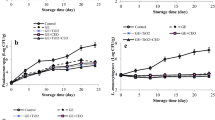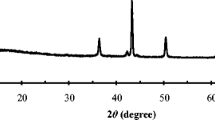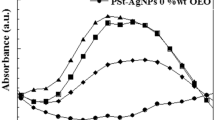Abstract
Because of the high perishability of eggs during storage, the aim of this study was to increase the shelf life of quail eggs by maintaining nutritional and quality characteristics with the production of biodegradable three-part film Ag/AgCl/TiO2 based on corn starch. So, the synthesis and characterization of Ag/AgCl /TiO2 three-component nanocomposite using Zataria bracteata Boiss plant was performed using the techniques of XRD, TEM and FTIR. Then, the physicochemical and microbial properties of the film were investigated and the resulting film was used to cover the eggs. The eggs’ physicochemical and microbial properties were evaluated during 27 days of storage. TEM images showed uniform loading of Ag /AgCl nanoparticles on the TiO2 surface. The highest solubility of the film (55.96%) was related to the control sample and the lowest (42.73%) was related to the film containing titanium dioxide. Furthermore, the highest modulus of elasticity (1.99 MPa) was observed in the control sample and the lowest (1.07 MPa) in the film containing a three-component nanocomposite. Also, the Ag/AgCl/TiO2 nanocomposite treatment had the lowest weight loss (5.44%) and lowest pH after 27 days egg storage. The results of Salmonella, Staphylococcus aureus, e.coli counts, total counts, and mold and yeast counts after 27 days of storage showed that the samples contain nanocomposites were significantly less contaminated than the control samples. In conclusion, the results showed that thyme extract, along with silver and titanium dioxide nanocomposites, has a high potential for the production of nanoparticles in high purity and nanometer sizes with antimicrobial properties and application in the food industry as it has a cover and a film.








Similar content being viewed by others
References
S. Kuroki et al., Nondestructive VIS/NIR spectroscopy estimation of intravitelline vitamin E and cholesterol concentration in hen shell eggs. J. Food Meas. Charact. 14(2), 1116–1124 (2020)
N. Homsaard et al., Efficacy of cassava starch blending with gelling agents and palm oil coating in improving egg shelf life. Int. J. Food Sci. Technol 56(8), 3655–3661 (2021)
P. Pires et al., Rice protein coating in extending the shelf-life of conventional eggs. Poult. Sci 98(4), 1918–1924 (2019)
H. Barikloo, E. Ahmadi, Effect of nanocomposite-based packaging and chitosan coating on the physical, chemical, and mechanical traits of strawberry during storage. J. Food Meas. Charact. 12(3), 1795–1817 (2018)
N. Kumar, Polysaccharide-based Component and Their Relevance in Edible film/coating: A Review (Nutrition & Food Science, 2019)
Y. Zhao et al., Ultra sensitive detection of malachite green in fish muscle with gold nanoparticles and graphene oxide hybrid as a substrate for surface enhanced Raman scattering. J. Food Meas. Charact. 14(2), 658–667 (2020)
D. Nath et al., Chap. 7 - Nanocomposites in food packaging, in Food, Medical, and Environmental Applications of Nanomaterials, ed. by K. Pal et al., (Elsevier, 2022), pp. 167–203
N. Ben Saber et al., A review of ternary nanostructures based noble metal/semiconductor for environmental and renewable energy applications. J. Mater. Res. Technol. 9(6), 15233–15262 (2020)
J. Fang et al., Au@ TiO2–CdS ternary nanostructures for efficient visible-light-driven hydrogen generation. ACS Appl. Mater. Interfaces 5(16), 8088–8092 (2013)
S.-E. Kim et al., A facile general route for ternary Fe2O3@ TiO2@ nanometal (au, ag) composite as a high-performance and recyclable photocatalyst. J. Ind. Eng. Chem 43, 142–149 (2016)
K. Flomin, M. Diab, T. Mokari, Ternary hybrid nanostructures of Au–CdS–ZnO grown via a solution–liquid–solid route using Au–ZnO catalysts. Nanoscale 9(42), 16138–16142 (2017)
A.-C. Burdușel et al., Biomedical applications of silver nanoparticles: an up-to-date overview. Nanomaterials 8(9), 681 (2018)
P. Mathur et al., Pharmaceutical aspects of silver nanoparticles. Artificial cells, nanomedicine, and biotechnology, 2018. 46(sup1): p. 115–126
S. Çeşmeli, C. Biray Avci, Application of titanium dioxide (TiO2) nanoparticles in cancer therapies. J. Drug Target 27(7), 762–766 (2019)
A. Shetta, J. Kegere, W. Mamdouh, Comparative study of encapsulated peppermint and green tea essential oils in chitosan nanoparticles: Encapsulation, thermal stability, in-vitro release, antioxidant and antibacterial activities. Int. J. Biol. Macromol 126, 731–742 (2019)
M.L. Badea et al., Peppermint essential oil-doped hydroxyapatite nanoparticles with antimicrobial properties. Molecules 24(11), 2169 (2019)
Y. Wang et al., Online preconcentration of lysozyme in hen egg white using responsive polymer coating in CE. J. Sep. Sci 44(18), 3477–3488 (2021)
C. Caner, B.M. Coşkun, M. Yüceer, Chitosan coatings and chitosan nanocomposite to enhancing storage stability of fresh egg during storage. Journal of Food Processing and Preservation, 2022: p. e16642
H. Ahari et al., Method for Producing Antimicrobial Nanofilms Packaging Cover Based on Titanium nano-dioxide Through Extrusion for Extension of food shelf-life (Google Patents, 2022)
Z. Ghasemi, V. Abdi, I. Sourinejad, Green fabrication of Ag/AgCl@ TiO2 superior plasmonic nanocomposite: biosynthesis, characterization and photocatalytic activity under sunlight. J. Alloys Compd 841, 155593 (2020)
R. Toker, N. Kayaman-Apohan, M. Kahraman, UV-curable nano-silver containing polyurethane based organic–inorganic hybrid coatings. Prog. Org. Coat 76(9), 1243–1250 (2013)
N. Nakayama, T. Hayashi, Preparation and characterization of poly (l-lactic acid)/TiO2 nanoparticle nanocomposite films with high transparency and efficient photodegradability. Polym. Degrad. Stab 92(7), 1255–1264 (2007)
X. Yang et al., Synthesis of silver-titanium dioxide nanocomposites for antimicrobial applications. J. Nanopart. Res 16(8), 1–13 (2014)
A. Sadeghi-Varkani, Z. Emam-Djomeh, G. Askari, Physicochemical and microstructural properties of a novel edible film synthesized from Balangu seed mucilage. Int. J. Biol. Macromol 108, 1110–1119 (2018)
E. Tavassoli-Kafrani, H. Shekarchizadeh, M. Masoudpour-Behabadi, Development of edible films and coatings from alginates and carrageenans. Carbohydr. Polym 137, 360–374 (2016)
A.S. Motad.B., et al., Internal quality of eggs coated with cassava and yam starches. 2017
M. Yüceer, C. Caner, The effects of ozone, ultrasound and coating with shellac and lysozyme–chitosan on fresh egg during storage at ambient temperature. Part II: microbial quality, eggshell breaking strength and FT-NIR spectral analysis. Int. J. Food Sci. Technol 55(4), 1629–1636 (2020)
J. Ahmed et al., Polylactide/poly (ε-caprolactone)/zinc oxide/clove essential oil composite antimicrobial films for scrambled egg packaging. Food Packaging and Shelf Life 21, 100355 (2019)
M. Parisi et al., Microbiological contamination of shell eggs produced in conventional and free-range housing systems. Food Control 47, 161–165 (2015)
R. Atchudan et al., In-situ green synthesis of nitrogen-doped carbon dots for bioimaging and TiO2 nanoparticles@ nitrogen-doped carbon composite for photocatalytic degradation of organic pollutants. J. Alloys Compd 766, 12–24 (2018)
T.N.J.I. Edison et al., Turn-off fluorescence sensor for the detection of ferric ion in water using green synthesized N-doped carbon dots and its bio-imaging. J. Photochem. Photobiol., B 158, 235–242 (2016)
N. Muthuchamy et al., High-performance glucose biosensor based on green synthesized zinc oxide nanoparticle embedded nitrogen-doped carbon sheet. J. Electroanal. Chem 816, 195–204 (2018)
B.-T.T. Pham et al., Development of polyvinyl (alcohol)/D-glucose/agar/silver nanoparticles nanocomposite film as potential food packaging material. J. Polym. Res 28(11), 1–14 (2021)
B. Dabirvaziri et al., A simple and effective synthesis of magnetic γ-Fe 2 O 3@ SiO 2@ TiO 2–Ag microspheres as a recyclable photocatalyst: dye degradation and antibacterial potential. Journal of Environmental Health Science and Engineering, 2019: p. 1–12
A. Bahrami et al., Physico-mechanical and antimicrobial properties of tragacanth/hydroxypropyl methylcellulose/beeswax edible films reinforced with silver nanoparticles. Int. J. Biol. Macromol 129, 1103–1112 (2019)
K. Saravanakumar et al., Green synthesis and characterization of biologically active nanosilver from seed extract of Gardenia jasminoides Ellis. J. Photochem. Photobiol., B 185, 126–135 (2018)
Y. Wang et al., Gelatin-based Nanocomposite Film with bacterial Cellulose–MgO nanoparticles and its application in Packaging of Preserved Eggs. Coatings 11(1), 39 (2021)
A. Biladeau, K. Keener, The effects of edible coatings on chicken egg quality under refrigerated storage. Poult. Sci 88(6), 1266–1274 (2009)
A.I. Mudannayaka, D.S.W. Rajapaksha, K.A.H.T. Kodithuwakku, Effect of Beeswax, gelatin and Aloe vera Gel Coatings on Physical Properties and Shelf Life of Chicken Eggs stored at 30 C. Scienceline Publication 6(1), 6–13 (2016)
P. Karvankova et al., Thermal stability of ZrN–Ni and CrN–Ni superhard nanocomposite coatings. Surf. Coat. Technol. 146, 280–285 (2001)
Acknowledgements
This research was supported by Islamic Azad University, Science and Research Branch, Tehran, Iran, and Special thanks to the Nanotechnology Laboratory for performing this research.
Author information
Authors and Affiliations
Corresponding author
Ethics declarations
Conflict of interest
None of the authors have any conflicts of interest to declare.
Additional information
Publisher’s Note
Springer Nature remains neutral with regard to jurisdictional claims in published maps and institutional affiliations.
Rights and permissions
Springer Nature or its licensor (e.g. a society or other partner) holds exclusive rights to this article under a publishing agreement with the author(s) or other rightsholder(s); author self-archiving of the accepted manuscript version of this article is solely governed by the terms of such publishing agreement and applicable law.
About this article
Cite this article
Mohammadi, S., Ahari, H. & Yousefi, S. Green synthesis of three-component Ag/AgCl/TiO2 nanocomposite using Zataria Multiflora plant and evaluation of its application in the production of the biodegradable film to increase egg durability in packaging. Food Measure 17, 3950–3961 (2023). https://doi.org/10.1007/s11694-023-01925-5
Received:
Accepted:
Published:
Issue Date:
DOI: https://doi.org/10.1007/s11694-023-01925-5




